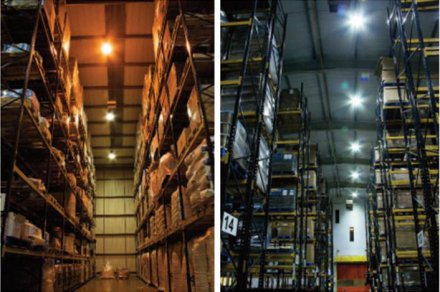Food warehouses save cost and energy with LED lighting
For the last three years Managing Director Paul Cope of UK based March Foods had been looking for a way to reduce energy consumption in his warehouses. After rejecting voltage controllers as old technology, he began to examine LED lighting as a potential smart solution.

The lighting challenge
Paul Cope describes the problems he wanted to solve: “We had two 3,250 square metre (35,000 sq ft)warehouses with a total of 84 x 450W HPS lamps operating 24/5 and Saturdays. Even though we are not constantlyin and out of all bays in the warehouse all the time, the old lamps couldn’t be switched off as they took 10-15minutes to re-strike, so I wanted a more energy efficient solution. And to be honest, the lighting was getting so thatLord Lucan could have hidden in our warehouse!”
“Then there’s the maintenance problem. With 15 metre high ceilings (49 ft) you need to bring in a cherrypicker to replace failed lamps and you can’t have people working underneath. That means we’d typically wait until4-8 lamps had failed before hiring the scissor lift over a weekend to replace them. This was costing about £2,000annually.”
How the challenge was overcome with LED lighting
Interior Control replaced the 84 x 450W HPS lamps on a one-to-one basis with the Dialight DuroSite™ SeriesLED High Bay. This highly robust 150W fitting features eight arrays in a compact oval pattern that enables it to directlight efficiently with less wastage and delivers an immediate saving in power of 66%. Unlike HPS, the LED lighting has instant-on ability, so it works well with occupancy sensors and this has furtherincreased energy saving to 72% as well as reducing carbon emissions by over 100 tonnes per year. The oval patternof the arrays also means less wasted light on racking and more directed at floor level in the aisles where 110 lux wasmeasured under the HPS, which had dimmed over time, increasing to 221 lux after the installation of the LED HighBays. Tom Klimes comments: “We’ve removed the maintenance burden by fitting LED lighting, as these High Bays arewarranted for five years of continuous performance and you can expect them to last ten or more if they’re not in use24/7.
